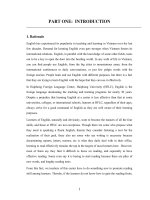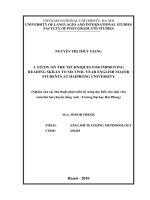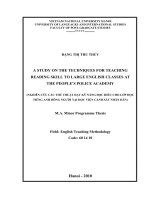Slide a study on the techniques for improving reading skills to non major students of english at hai phong foreign language center,hai phong university
Bạn đang xem bản rút gọn của tài liệu. Xem và tải ngay bản đầy đủ của tài liệu tại đây (502.01 KB, 21 trang )
A study on
A study on
the techniques for improving reading skills
the techniques for improving reading skills
to non-major students of English
to non-major students of English
at Haiphong foreign language center,
at Haiphong foreign language center,
Haiphong university
Haiphong university
(Nghiên cứu các thủ thuật nâng cao kỹ năng đọc hiểu cho học viên
tiêng Anh không chuyên tại Trung tâm Ngoại ngữ- Tr ờng Đại học
Hải Phòng)
Part one:
Part one:
Introduction
Introduction
Part two:
Part two:
Development
Development
Part three:
Part three:
Conclusion
Conclusion
Part one: Introduction
1. Rationale
2. Aims of the study
3. Scope of the study
4. Methods of the study
5. Design of the study
Part two: Development
Chapter one: Literature Review
Chapter one: Literature Review
1.1. An Overview on the Nature of Reading
1.1. An Overview on the Nature of Reading
1.1.1. Definition of Reading
1.1.1. Definition of Reading
1.1.2. Reading comprehension
1.1.2. Reading comprehension
1.1.3. Reading process
1.1.3. Reading process
1.2.
1.2.
Classification of Reading
Classification of Reading
1.2.1. According to Manner
1.2.1. According to Manner
1.2.2. According to Purpose
1.2.2. According to Purpose
1.3.
1.3.
Effective Reading Comprehension and
Effective Reading Comprehension and
Reading Comprehension techniques
Reading Comprehension techniques
1.3.1. Effective Reading Comprehension
1.3.1. Effective Reading Comprehension
1.3.2. Reading Comprehension techniques
1.3.2. Reading Comprehension techniques
Part two: Development
Chapter two
Chapter two
:
:
An Investigation into the Current Situation of
An Investigation into the Current Situation of
Teaching and Learning Reading at Haiphong
Teaching and Learning Reading at Haiphong
Foreign Language Center – Haiphong
Foreign Language Center – Haiphong
University
University
2.1. An Overview on HFLC
2.1. An Overview on HFLC
2.2. Learners and Learning Requirements
2.2. Learners and Learning Requirements
2.3.Teachers and Teaching
2.3.Teachers and Teaching
Methods
Methods
2.4. Materials and Assessments
2.4. Materials and Assessments
2.5. Data Collection, Findings and
2.5. Data Collection, Findings and
Discussion
Discussion
Survey Questionnaire
Part two: Development
E.g.
E.g.
9. Do your teachers often encourage you to
9. Do your teachers often encourage you to
have extensive reading outside classroom?
have extensive reading outside classroom?
a.
a.
usually
usually
b.
b.
sometimes
sometimes
c.
c.
seldom
seldom
d.
d.
never
never
Options
Options
Questions
Questions
A
A
B
B
C
C
D
D
E
E
7
7
3.3%
3.3%
17.5%
17.5%
66.6%
66.6%
8.3%
8.3%
8
8
2.5%
2.5%
6.3%
6.3%
2.5%
2.5%
78.6%
78.6%
10%
10%
9
9
0%
0%
66.6%
66.6%
25%
25%
8.3%
8.3%
Table 3
Table 3
:
:
Teachers’ activities towards their students
Teachers’ activities towards their students
in
in
the reading lesson
the reading lesson
Part two: Development
Chapter three
Chapter three
:
:
Suggested Techniques to Improve Reading Skill
Suggested Techniques to Improve Reading Skill
to Non-major Students at HFLC
to Non-major Students at HFLC
3.1. Techniques for Reading Interest and
3.1. Techniques for Reading Interest and
Motivation
Motivation
3.1.1. Making English Reading Fun
3.1.1. Making English Reading Fun
3.1.2. Making English Reading Useful
3.1.2. Making English Reading Useful
3.2.Techniques for Training Students to Become
3.2.Techniques for Training Students to Become
Efficient Readers
Efficient Readers
3.2.1. Making Students Aware of the Nature
3.2.1. Making Students Aware of the Nature
of Reading Process
of Reading Process
3.2.2. Promoting Students to Be Fully
3.2.2. Promoting Students to Be Fully
Aware of Their Purpose of Reading
Aware of Their Purpose of Reading
3.2.3. Activating Students to Work Willingly in
3.2.3. Activating Students to Work Willingly in
Different Stages of Reading
Different Stages of Reading
3.2.4. Encouraging Students to Have Extensive
3.2.4. Encouraging Students to Have Extensive
Reading Habit
Reading Habit
3.3.Techniques for the Improvement of
3.3.Techniques for the Improvement of
Teachers’ activities in Reading Lesson
Teachers’ activities in Reading Lesson
3.3.1. Adjusting Teaching Time and Efforts
3.3.1. Adjusting Teaching Time and Efforts
3.3.2. Varying Strategies to Aid the Students
3.3.2. Varying Strategies to Aid the Students
in Three Phases of a Reading Lesson
in Three Phases of a Reading Lesson
3.4.Techniques for the Development of Reading
3.4.Techniques for the Development of Reading
Materials
Materials
3.4.1. Making Full Use of the Reading Texts
3.4.1. Making Full Use of the Reading Texts
and Designing Reading Text Based Activities
and Designing Reading Text Based Activities
3.4.2. Selecting Appropriate Supplementary
3.4.2. Selecting Appropriate Supplementary
Reading Materials
Reading Materials
Part three: Conclusion
1. Recapitulation
1. Recapitulation
2. Limitations and Suggestions for
2. Limitations and Suggestions for
Further Studies
Further Studies
Varying strategies to aid the students
in three phases of a reading lesson
At Pre-reading Phase:
At Pre-reading Phase:
Teachers should:
Teachers should:
Establish a reason for students to read
Establish a reason for students to read
Establish the context
Establish the context
A
A
ctivate existing cultural knowledge
ctivate existing cultural knowledge
Express an attitude/opinion in relation to the topic
Express an attitude/opinion in relation to the topic
Review their own experience about the topic
Review their own experience about the topic
At While-reading Phase
At While-reading Phase
Ask the students to possibly:
Ask the students to possibly:
follow the order of ideas in a text
follow the order of ideas in a text
react to the opinions expressed
react to the opinions expressed
understand the information the text contains
understand the information the text contains
ask themselves questions related
ask themselves questions related
make notes
make notes
Encourage silent reading
Encourage silent reading
Enhance extensive reading
Enhance extensive reading
Use a range of exercises
Use a range of exercises
Provide a chart
Provide a chart
Teachers should
Teachers should
At Post-reading
Phase:
Teachers should encourage:
Teachers should encourage:
Discussion
Discussion
Debate
Debate
Role-play
Role-play
Reading of contrasting texts
Reading of contrasting texts
Summarizing the text
Summarizing the text
Reading-based speaking and writing topics
Reading-based speaking and writing topics
THANKS FOR YOUR
THANKS FOR YOUR
ATTENTION !
ATTENTION !








